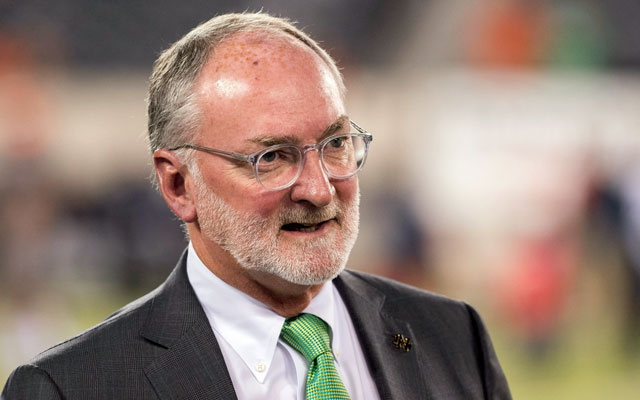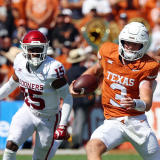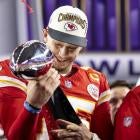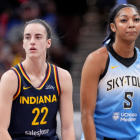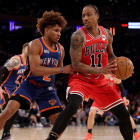Jack Swarbrick has this vision. In it, schools that want to pay their athletes and those that want to adhere to a strict educational mission have a decision to make.
In his vision, a players union may not be the worst thing in the world. In it, Congress may have a hand in governing college sports.
The Notre Dame athletic director says there is currently a “cultural divide” in college athletics, one that may make the traditional version of conference realignment look like a game of jacks.
Swarbrick isn’t necessarily advocating upheaval, just defining the future. The legal, moral and collegiate pressures may make it inevitable for a semi-pro division of college athletics to emerge.
“There’s going to be Congressional intervention [in college athletics] or there’s going to be more than one intercollegiate athletic association ….” he said.
“You don’t like these set of rules? Go play in that association.”
A financial windfall in television rights caused the last round of realignment. That eventually pushed Notre Dame to the ACC in everything but football. Swarbrick speaks freely because he still represents one school, one philosophy -- not a conference of merging interests.
Notre Dame has called its shots through the history of major-college athletics.
The Fighting Irish basically jump-started modern conference realignment when they bolted the College Football Association for NBC in 1990.
In Swarbrick’s vision, be assured the Notre Dame’s voice will be heard.
Meanwhile, the NCAA is trying to maintain its relevance under an avalanche of legal challenges and reform. One insider said the amount of legal scrutiny has turned the NCAA into “the new tobacco industry.”
| Replacing The NCAA* | ||
| This is how two new collegiate athletic associations might look if financial and academic pressures force schools to make a philosophical decision. For these purposes, we're naming them the Federal Collegiate Athletic Association (FCAA) -- similar to the current NCAA -- and College Sports United (CSU) -- for semi-pros. *FBS schools only | ||
| FCAA | CSU | |
| Air Force | Alabama | |
| Akron | Arizona | |
| Appalachian State | Arizona State | |
| Arkansas State | Arkansas | |
| Army | Auburn | |
| Ball State | Baylor | |
| Boston College | Boise State | |
| Bowling Green | BYU | |
| Buffalo | Cincinnati | |
| Cal | Clemson | |
| Central Michigan | Colorado | |
| FAU | Colorado State | |
| FIU | UConn | |
| Fresno State | East Carolina | |
| Georgia Southern | Florida | |
| Georgia State | Florida State | |
| Hawaii | Georgia | |
| Idaho | Georgia Tech | |
| Kent State | Houston | |
| Louisiana-Monroe | Illinois | |
| UMass | Indiana | |
| Miami (OH) | Iowa State | |
| Middle Tennessee | Kansas | |
| Navy | Kansas State | |
| New Mexico | Kentucky | |
| New Mexico State | Louisiana-Lafayette | |
| North Texas | LSU | |
| Northern Illinois | Louisiana Tech | |
| Northwestern | Louisville | |
| Notre Dame | Marshall | |
| Ohio | Maryland | |
| Old Dominion | Memphis | |
| Rice | Miami (FL) | |
| San Jose State | Michigan | |
| SMU | Michigan State | |
| South Alabama | Minnesota | |
| Southern Miss | Ole Miss | |
| Stanford | Mississippi State | |
| Temple | Missouri | |
| TCU | Nebraska | |
| Texas-San Antonio | Nevada | |
| Texas State | North Carolina | |
| Toledo | NC State | |
| Troy | Ohio State | |
| Tulane | Oklahoma | |
| Tulsa | Oklahoma State | |
| Vanderbilt | Oregon | |
| Virginia | Oregon State | |
| Wake Forest | Penn State | |
| Western Michigan | Pittsburgh | |
| Wyoming | Purdue | |
| - | Rutgers | |
| - | San Diego State | |
| - | South Carolina | |
| - | Syracuse | |
| - | Tennessee | |
| - | Texas | |
| - | Texas A&M | |
| - | Texas Tech | |
| - | UCF | |
| - | UCLA | |
| - | UNLV | |
| - | USC | |
| - | USF | |
| - | Utah | |
| - | Utah State | |
| - | UTEP | |
| - | Virginia Tech | |
| - | Washington | |
| - | Washingon State | |
| - | West Virginia | |
| - | Western Kentucky | |
| - | Wisconsin | |
| - | Iowa | |
Congressional intervention has been mentioned as a way to turn down the heat. It would provide the NCAA with, say, an anti-trust exemption that could protect the association against some of those legal challenges.
Lately, though, any federal intervention has trended toward reining in NCAA power rather than expanding it.
“Forget the economics, the cultural divide in college athletics is getting too big,” Swarbrick said. “Any business association requires commonality of interests to hold together.
“The Oregon and Stanford economic models are similar. Their approach to sports couldn’t be more different.”
Oregon is a state school with a mission to provide a practical education accessible to all. Stanford is a private research institution with a mission is to offer an elite broad-based education.
They both play in the Pac-12. In Swarbrick’s future vision, they would be affiliated with different governing bodies.
There would be schools banding together because they adhere to a traditional collegiate model. For example, the Ivy League doesn’t offer athletic scholarships or participate in the FCS playoff. Still, it is in Division I.
“It’s a decision the Ivy League made a long time ago,” Swarbrick said. “Other schools will say, ‘Hey, we’re comfortable with sort of semi-pro model.’ That’s a perfectly valid choice. But for some of us that’s not a choice we’re prepared to make and we won’t.”
Swarbrick knows his stuff. If all this seems to be a trend toward an Olympic model, there’s a reason. There was a time when the USOC held on to a pure amateur model. Now, no one cares if that dainty figure skater has a six-figure endorsement contract with a major airline.
As a member of the Indiana Sports Commission, Swarbrick -- an attorney by trade -- worked closely with the NFL and USOC in landing events for Indianapolis.
“Most athletic budgets are somewhere around the 3-8 percent range” of the total university budget, according to Swarbrick. “The Stanfords of the world are not going to allow that 4 percent business unit [to] take them places they don’t want to be.”
Think, then, of two college sports associations. One that includes the likes of Notre Dame, Duke, Stanford, Wake Forest, Cal, Northwestern and TCU. And another that includes most of the major-college land-grant schools.
Recruiting issues? Big Ten commissioner Jim Delany has already laid down a challenge. Similar to 1990, any division that includes Notre Dame is going to get a hefty TV contract.
The current conference media rights deals, worth billions, generally lock in the 10 FBS conferences to the middle of the next decade. The current external pressures could impact those deals way before that time.
Two associations would reflect differing academic approaches. Schools could conceivably still play each other -- as long as the public can digest a $20,000-a-year Isaiah Taylor from Texas bringing it up against Duke’s Tyus Jones.
That vision portends a future when schools won’t necessarily be defined by their conferences but by their core beliefs. College leaders are already being forced to consider outright compensation, a concept that would have been unthinkable a few years ago.
Athletes are already being compensated with the new cost of attendance. If the NCAA loses the O’Bannon case, players could make up to $20,000 in a trust fund payable after they leave school. Several lawsuits against the NCAA and Power Five conferences are calling for the full-on payment of athletes.
Northwestern is still waiting on a National Labor Relations Board ruling that would allow private-school athletes to unionize.
“The irony of all this is, maybe the only way we can get resolution is to ask our athletes to unionize,” Swarbrick said.
That, at least, would bring some sort of cost certainty instead of spending endless hours in court.
“You could have an enforceable collective bargaining,” Swarbrick said.
That’s quite a vision.
